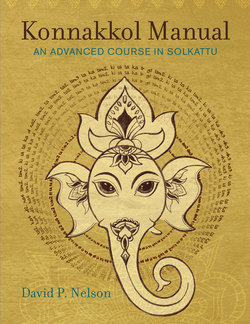Читать книгу Konnakkol Manual - David P. Nelson - Страница 7
На сайте Литреса книга снята с продажи.
ОглавлениеPREFACE
My first book, Solkaṭṭu Manual, was published in 2008. Neither I nor the wonderful team at Wesleyan University Press had any idea whether it might find an audience at all, or if it did, who might make up such an audience. We have all been pleasantly surprised to find that yes, it did find an audience, large enough to require a second printing. It is still available as of this writing.
I knew the material was solid since I had developed it in my solkaṭṭu classes at Wesleyan University. I had observed firsthand the enthusiasm and engagement of my students, very few of whom were percussionists, and even fewer of whom continued into the study of mṛdaṅgam. What I had not imagined was that this material, and my approach to it, would have an international reach. So I was pleasantly surprised when, a year or two after Solkaṭṭu Manual’s publication, I received an e-mail from a German jazz drummer named Christian Scheuber. Christian had enjoyed working with the book and wanted to know whether I had more advanced material, and whether it was possible to work together over Skype. Chris and I began a fruitful working relationship that culminated in my composing a duet piece for mṛdaṅgam and drum set in miśra capu tāḷa, the seven-beat cycle featured in chapter 6, “Miśra Capu Tāḷa,” of this book. We recorded the piece, which was later released on the CD Shapes of Four, a suite composed by the pianist Regina Litvinova for her quartet. I traveled to Ludwigshafen, Germany, in 2014 to perform in the world premiere of Shapes of Four, and Chris and I have been fast friends ever since. He has done a full German translation of Solkaṭṭu Manual, which has yet to be published.
In 2014 I got another unexpected e-mail, this time from Poorya Pakshir in Iran. Poorya is an expert performer and teacher on the tombak, one of Iran’s principal percussion instruments. After we had exchanged a few messages, he asked for permission to translate Solkaṭṭu Manual into the Persian language. His translation work coincided with our revisions ahead of the second English printing, and he found errors in the original version that nobody else, myself included, had noticed. His Persian translation has since been published in Iran. Poorya entered Wesleyan’s graduate program in music in September 2016, where he earned his MA and is about to begin his doctoral studies.
The questions these two students from widely divergent cultural and musical backgrounds asked, and the questions I have been asked by many other musicians within the Wesleyan community and beyond, gave me faith that a second book, made up of more advanced material, might be worth writing. I wanted to present material that unlocked some of the apparent mysteries in the Karṇāṭak rhythmic system so that these and other musicians could participate in the development of their own new material.
With that purpose in mind, I present here exercises and compositions, many of which are based on those found in Solkaṭṭu Manual, that demonstrate the modes of transformation Karṇāṭak musicians use in their rhythmic creations. I also describe some of the techniques I use in teaching and learning this challenging music. The book includes descriptions of all of its contents, as well as notation and more than one hundred fifty video examples of individual exercises, compositions, and full konnakkol performances.
What exactly is konnakkol? The word is from the Tamil language, as is solkaṭṭu, but unlike the latter, which can be translated into English as “words or syllables (sol, or sollu) bound together (kaṭṭu),” konnakkol does not have an agreed-on English equivalent. I use it here to mean solkaṭṭu intended for performance. Within the book, then, I consider the exercises in chapter 5, “Exercises in Tiśra Naḍai and Khaṇḍa Naḍai,” as solkaṭṭu, while the tani āvartanams detailed in chapters 6, 7, and 8 are konnakkol, since they are designed for performance.
I invite the reader to enjoy working through this material, either as self-study or as a group endeavor, and to enjoy the voyage into a new world of rhythmic behavior. Remember that your imagination is limitless, constrained only by your effort and interest.
